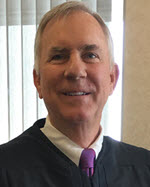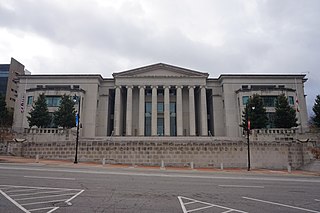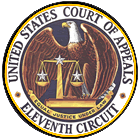Wallace v. Jaffree, 472 U.S. 38 (1985), was a United States Supreme Court case deciding on the issue of silent school prayer.

The United States District Court for the Middle District of Alabama is a federal court in the Eleventh Circuit.
In United States law, the Establishment Clause of the First Amendment to the United States Constitution, together with that Amendment's Free Exercise Clause, form the constitutional right of freedom of religion. The relevant constitutional text is:
Congress shall make no law respecting an establishment of religion...
McCreary County v. American Civil Liberties Union of Kentucky, 545 U.S. 844 (2005), was a case argued before the Supreme Court of the United States on March 2, 2005. At issue was whether the Court should continue to inquire into the purpose behind a religious display and whether evaluation of the government's claim of secular purpose for the religious displays may take evolution into account under an Establishment Clause of the First Amendment analysis.
Van Orden v. Perry, 545 U.S. 677 (2005), is a United States Supreme Court case involving whether a display of the Ten Commandments on a monument given to the government at the Texas State Capitol in Austin violated the Establishment Clause of the First Amendment.

William Holcombe Pryor Jr. is an American lawyer who has served as the chief judge of the United States Court of Appeals for the Eleventh Circuit since 2020. He was appointed as a United States circuit judge of the court by President George W. Bush in 2004. He is a former commissioner of the United States Sentencing Commission. Previously, he was the attorney general of Alabama, from 1997 to 2004.

The Supreme Court of Alabama is the highest court in the state of Alabama. The court consists of a chief justice and eight associate justices. Each justice is elected in partisan elections for staggered six-year terms. The Supreme Court is housed in the Heflin-Torbert Judicial Building in downtown Montgomery, Alabama.
Drayton Nabers Jr. is an American lawyer and former Chief Justice of the Alabama Supreme Court. He was appointed to the court in 2003 by Governor Bob Riley following Chief Justice Roy Moore's removal as a result of his refusal to remove his Ten Commandments Monument from the State Judicial Building despite a federal court order to do so, an event that attracted national media attention.

Roy Stewart Moore is an American politician, lawyer, and jurist who served as chief justice of the Supreme Court of Alabama from 2001 to 2003 and again from 2013 to 2017, each time being removed from office for judicial misconduct by the Alabama Court of the Judiciary. He was the Republican Party nominee in the 2017 U.S. Senate special election in Alabama to fill the seat vacated by Jeff Sessions, but was accused by several women of sexually assaulting them while they were underage and lost to Democratic candidate Doug Jones. Moore ran unsuccessfully for the same Senate seat in 2020.

David Brookman Smith, known professionally as D. Brooks Smith, is a senior United States circuit judge of the United States Court of Appeals for the Third Circuit. He was previously Chief Judge of both the United States Court of Appeals for the Third Circuit and the United States District Court for the Western District of Pennsylvania, and is the only judge in the history of the Third Circuit to have served as both a chief district judge and chief of the Court of Appeals. Since January 2022, Smith has served as Penn State Law's new jurist in residence.
In Stone v. Graham, 449 U.S. 39 (1980), the Supreme Court of the United States ruled that a Kentucky statute was unconstitutional and in violation of the Establishment Clause of the First Amendment, because it lacked a nonreligious, legislative purpose. The statute required the posting of a copy of the Ten Commandments on the wall of each public classroom in the state. The copies of the Ten Commandments were purchased with private funding, but the Court ruled that because they were being placed in public classrooms they were in violation of the First Amendment.
Clement Clay "Bo" Torbert Jr. was an American jurist. He was the twenty-fifth Chief Justice of the Alabama Supreme Court from 1977 through 1989.

Loretta A. Preska is an American lawyer who serves as a senior United States district judge of the United States District Court for the Southern District of New York. Born in Albany, Preska received law degrees from Fordham University School of Law and New York University School of Law. She practiced law in New York City from 1973 to 1992 at the law firms of Cahill Gordon & Reindel and Hertzog, Calamari & Gleason. President George H. W. Bush appointed her to the district bench in 1992. She served as chief judge of the court for a seven-year term from 2009 to 2016, and took senior status in 2017. President George W. Bush nominated Preska to the U.S. Court of Appeals for the Second Circuit in 2008, but the Senate did not act on the nomination.

Robert Clive Jones is a senior United States district judge of the United States District Court for the District of Nevada. He served as the Chief United States District Judge from 2011 to 2014.
Pleasant Grove City v. Summum, 555 U.S. 460 (2009), is a decision from the Supreme Court of the United States which ruled on the U.S. Constitution's prohibition on a government establishment of religion specifically with respect to monuments on public land.
Salazar v. Buono, 559 U.S. 700 (2010), was a decision by the Supreme Court of the United States regarding the establishment clause of the First Amendment to the United States Constitution. The case concerned the legality of the Mojave Memorial Cross, a Latin cross which was placed atop a prominent rock outcropping by the Veterans of Foreign Wars foundation in 1934 to honor war dead. The location is known as "Sunrise Rock" in the Mojave National Preserve in San Bernardino County in southeastern California. The Supreme Court ruled that the cross may stay, but also sent the case back to a lower court, making the issue currently unresolved.

Green v. Haskell County Board of Commissioners, 568 F.3d 784, was a First Amendment case concerning the placing of a Ten Commandments monument on public property, an alleged violation of the separation of church and state.

Heflin-Torbert Judicial Building, commonly called the Alabama Judicial Building, is a state government building in Montgomery, Alabama. It houses several state judicial agencies, most notably the Supreme Court of Alabama, Alabama Court of Civil Appeals, and Alabama Court of Criminal Appeals. It is the first state court building in the United States to house all three courts under one roof. Additionally, it houses the State Law Library.

Robert Smith Vance Jr. is an American lawyer and jurist who is a circuit court judge on Alabama's 10th Judicial Circuit, located in Birmingham, Alabama.
Ten Commandments Monument may refer to:










